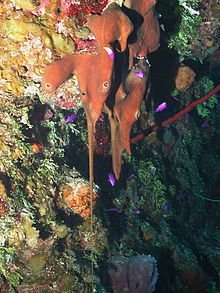| Plakinidae | |
|---|---|
 | |
| Plakortis sp. | |
| Scientific classification | |
| Domain: | Eukaryota |
| Kingdom: | Animalia |
| Phylum: | Porifera |
| Class: | Homoscleromorpha |
| Order: | Homosclerophorida |
| Family: | Plakinidae Schulze, 1880 [1] |
| Genera | |
see text | |
Plakinidae is a family of marine sponges. It is composed of eight genera: [1]
Plakinidae and Oscarellidae are the two families that compose the fourth and smallest class of the porifera phylum, Homoscleromorpha. [2]
- Aspiculophora Ruiz, Muricy, Lage, Domingos, Chenesseau & Pérez, 2017
- Aspiculophora madinina Ruiz, Muricy, Lage, Domingos, Chenesseau & Pérez, 2017
- Aspiculophora papillata Ruiz, Ereskovsky & Pérez, 2022
- Aspiculortis Ruiz, Ereskovsky & Pérez, 2022
- Aspiculortis garifuba Ruiz, Ereskovsky & Pérez, 2022
- Corticium Schmidt, 1862
- Corticium acanthastrum Thomas, 1968
- Corticium bargibanti Lévi & Lévi, 1983
- Corticium candelabrum Schmidt, 1862
- Corticium diamantense Ereskovsky, Lavrov & Willenz, 2014
- Corticium furcatum Muricy, Sarmento, Lage, Almeida & Fromont, 2021
- Corticium monolophum Muricy, Sarmento, Lage, Almeida & Fromont, 2021
- Corticium niger Pulitzer-Finali, 1996
- Corticium quadripartitum Topsent, 1923
- Corticium simplex Lendenfeld, 1907
- Corticium vaceleti Lage, Muricy, Ruiz & Pérez, 2018
- Corticium verticillatum Muricy, Sarmento, Lage, Almeida & Fromont, 2021
- Placinolopha Topsent, 1897
- Placinolopha acantholopha (Thomas, 1970)
- Placinolopha bedoti Topsent, 1897
- Placinolopha europae Vacelet & Vasseur, 1971
- Placinolopha moncharmonti (Sarà, 1960)
- Placinolopha sarai Lévi & Lévi, 1989
- Placinolopha spinosa Kirkpatrick, 1900
- Plakina Schulze, 1880
- Plakina anisoactina Lage, Gerovasileiou, Voultsiadou & Muricy, 2018
- Plakina anomala Lage, Gerovasileiou, Voultsiadou & Muricy, 2018
- Plakina antarctica Lendenfeld, 1907
- Plakina arletensis Ruiz, Muricy, Lage, Domingos, Chenesseau & Pérez, 2017
- Plakina atka Lehnert, Stone & Heimler, 2005
- Plakina australis (Gray, 1867)
- Plakina bioxea Green & Bakus, 1994
- Plakina bowerbanki (Sarà, 1960)
- Plakina brachylopha Topsent, 1927
- Plakina cabofriensis Muricy, Domingos, Lage, Lanna, Hardoim, Laport & Zilberberg, 2019
- Plakina coerulea Cedro, Hajdu & Correia, 2013
- Plakina corticioides Vacelet, Vasseur & Lévi, 1976
- Plakina corticolopha Lévi & Lévi, 1983
- Plakina crypta Muricy, Boury-Esnault, Bézac & Vacelet, 1998
- Plakina cyanorosea Muricy, Domingos, Lage, Lanna, Hardoim, Laport & Zilberberg, 2019
- Plakina dilopha Schulze, 1880
- Plakina doudou Grenier, Ruiz, Lage & Pérez, 2020
- Plakina elisa (de Laubenfels, 1936)
- Plakina endoumensis Muricy, Boury-Esnault, Bézac & Vacelet, 1998
- Plakina finispinata Lage, Muricy, Ruiz & Pérez, 2018
- Plakina fragilis Desqueyroux-Faúndez & van Soest, 1997
- Plakina hellenica Lage, Gerovasileiou, Voultsiadou & Muricy, 2018
- Plakina jamaicensis Lehnert & van Soest, 1998
- Plakina jani Muricy, Boury-Esnault, Bézac & Vacelet, 1998
- Plakina kanaky Ruiz & Pérez, 2015
- Plakina lendenfeldi Van Soest & Hooper, 2020
- Plakina microlobata Desqueyroux-Faúndez & van Soest, 1997
- Plakina monolopha Schulze, 1880
- Plakina muricyae Cruz-Barraza, Vega & Carballo, 2014
- Plakina nathaliae (Ereskovsky, Lavrov & Willenz, 2014)
- Plakina pacifica Desqueyroux-Faúndez & van Soest, 1997
- Plakina paradilopha Cruz-Barraza, Vega & Carballo, 2014
- Plakina reducta (Pulitzer-Finali, 1983)
- Plakina strongylata Lage, Araujo, Gerovasileiou & Muricy, 2018
- Plakina tanaga Lehnert, Stone & Heimler, 2005
- Plakina tetralopha (Hechtel, 1965)
- Plakina tetralophoides Muricy, Boury-Esnault, Bézac & Vacelet, 1998
- Plakina topsenti (Pouliquen, 1972)
- Plakina trilopha Schulze, 1880
- Plakina versatilis (Schmidt, 1880)
- Plakina weinbergi Muricy, Boury-Esnault, Bézac & Vacelet, 1998
- Plakinastrella Schulze, 1880
- Plakinastrella ceylonica (Dendy, 1905)
- Plakinastrella clathrata Kirkpatrick, 1900
- Plakinastrella clippertonensis Van Soest, Kaiser & Van Syoc, 2011
- Plakinastrella copiosa Schulze, 1880
- Plakinastrella globularis Domingos, Moraes & Muricy, 2013
- Plakinastrella mammillaris Lendenfeld, 1907
- Plakinastrella microspiculifera Moraes & Muricy, 2003
- Plakinastrella minor (Dendy, 1916)
- Plakinastrella mixta Maldonado, 1992
- Plakinastrella nicoleae Lage, Muricy, Ruiz & Pérez, 2018
- Plakinastrella onkodes Uliczka, 1929
- Plakinastrella osculifera Lage, Muricy, Ruiz & Pérez, 2018
- Plakinastrella oxeata Topsent, 1904
- Plakinastrella polysclera Lévi & Lévi, 1989
- Plakinastrella pseudolopha Lage, Muricy, Ruiz & Pérez, 2018
- Plakinastrella stinapa Van Soest, Meesters & Becking, 2014
- Plakinastrella trunculifera Topsent, 1927
- Plakortis Schulze, 1880
- Plakortis albicans Cruz-Barraza & Carballo, 2005
- Plakortis angulospiculatus (Carter, 1882)
- Plakortis badabaluensis Ubare & Mohan, 2016
- Plakortis bergquistae Muricy, 2011
- Plakortis clarionensis Cruz-Barraza, Vega & Carballo, 2014
- Plakortis communis Muricy, 2011
- Plakortis copiosa Pulitzer-Finali, 1993
- Plakortis dariae Ereskovsky, Lavrov & Willenz, 2014
- Plakortis deweerdtaephila Vicente, Zea & Hill, 2016
- Plakortis edwardsi Ereskovsky, Lavrov & Willenz, 2014
- Plakortis erythraena Lévi, 1958
- Plakortis fromontae Muricy, 2011
- Plakortis galapagensis Desqueyroux-Faúndez & van Soest, 1997
- Plakortis halichondrioides (Wilson, 1902)
- Plakortis hooperi Muricy, 2011
- Plakortis insularis Moraes & Muricy, 2003
- Plakortis japonica (Hoshino, 1977)
- Plakortis kenyensis Pulitzer-Finali, 1993
- Plakortis lita de Laubenfels, 1954
- Plakortis mesophotica Idan, Shefer, Feldstein & Ilan, 2021
- Plakortis microrhabdifera Moraes & Muricy, 2003
- Plakortis myrae Ereskovsky, Lavrov & Willenz, 2014
- Plakortis nigra Lévi, 1953
- Plakortis petrupaulensis Domingos, Moraes & Muricy, 2013
- Plakortis potiguarensis Domingos, Moraes & Muricy, 2013
- Plakortis pulvillus Samaai, Pillay & Janson, 2019
- Plakortis quasiamphiaster Díaz & van Soest, 1994
- Plakortis ruetzleri Lage, Muricy, Ruiz & Pérez, 2018
- Plakortis simplex Schulze, 1880
- Plakortis spinalis Domingos, Moraes & Muricy, 2013
- Plakortis symbiotica Vicente, Zea & Hill, 2016
- Plakortis zyggompha (de Laubenfels, 1934)
- Tetralophophora Rützler, Piantoni, van Soest & Díaz 2014
- Tetralophophora mesoamericana Rützler, Piantoni, van Soest & Díaz 2014